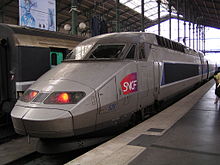TGV Réseau
| SNCF TGV "Réseau" | |
|---|---|

TGV-R set at Paris Gare du Nord
|
|
| In service | 1993 - |
| Manufacturer | GEC-Alsthom |
| Family name | TGV |
| Number built | 60 trainsets |
| Formation | 10 cars (2 power cars, 8 passenger cars) |
| Capacity | 377, 361 (after refurbishment) |
| Operator(s) |
SNCF Thalys |
| Specifications | |
| Train length | 200.19 m (656.8 ft) |
| Car length | (?) |
| Width | Motor car 2.81 m (9 ft 3 in) Trailer 2.904 m (9 ft 6.3 in) |
| Maximum speed | 320 km/h (199 mph) (Service) |
| Weight | 383 t (377 long tons; 422 short tons) (dual voltage) |
| Power output | 8,800 kW (11,800 hp) @ 25 kV |
| Power supply | (?) |
| Electric system(s) |
Overhead lines 25 kV 50 Hz AC 1,500 V DC 3 kV DC |
| Current collection method | Pantograph |
| UIC classification | Bo'Bo'+2'2'2'2'2'2'2'2'2'+Bo'Bo' |
| Track gauge | 1,435 mm (4 ft 8 1⁄2 in) standard gauge |
The SNCF TGV Réseau (TGV-R) trains were built by Alstom between 1992 and 1996. These TGV trainsets are based on the earlier TGV Atlantique.
The first Réseau ("Network") sets entered service in 1993. Fifty dual-voltage trainsets were built in 1992-1994, numbered 501-550. A further 40 triple-voltage trainsets, numbered 4501-4540, were built in 1994-1996. The last ten triple voltage units carry the Thalys livery and are known as Thalys PBA (Paris-Brussels-Amsterdam) sets. As well as using standard French voltages of 25 kV AC and 1,500 V DC (also used in the Netherlands), the triple voltage sets can operate under the Belgian and Italian 3 kV DC supplies.
They are formed of two power cars (8,800 kW or 11,800 hp under 25 kV—like the TGV Atlantique) and eight carriages, giving a capacity of 377 seats. They have a top speed of 300 km/h (186 mph). They are 200 m (656 ft) long and are 2.904 m (9 ft 6.3 in) wide. The dual-voltage sets weigh 383 t (377 long tons; 422 short tons), and owing to axle-load restrictions in Belgium the triple-voltage sets have a series of modifications, such as the replacement of steel with aluminium and hollow axles, to reduce the weight to under 17 t (16.7 long tons; 18.7 short tons) per axle.
Owing to early complaints of uncomfortable pressure changes when entering tunnels at high speed on the LGV Atlantique, the Réseau sets are pressure-sealed.
After some ten years of successful service, the interior of TGV Réseau sets became outdated and needed a refurbishment. This refurbishment was part of the TGV Est project, as the dual-voltage sets were to assure the domestic services there. The same interiors would also be used in coaches for POS sets (which were coaches of former TGV-Réseau sets).
Three possible interiors were presented to the public between 2002 and 2003 in different stations:
...
Wikipedia
